Max Linder and his wife quarrel and he is left to his own devices. Alas, keeping house is not nearly as easy as he imagined and chaos ensues in this cute domestic comedy.
Man vs. Kitchen
Max Linder is magical. At a time when movie cameras were still dutifully keeping their distance and comedy could be crude, Linder was a burst of confetti, a sparkling personality that transcended the keep-your-distance cinematography. Linder’s main persona was a man-about-town in a silk hat but he embraced several sub-genres of comedy including slapstick, political satire and, as we see here, domestic.
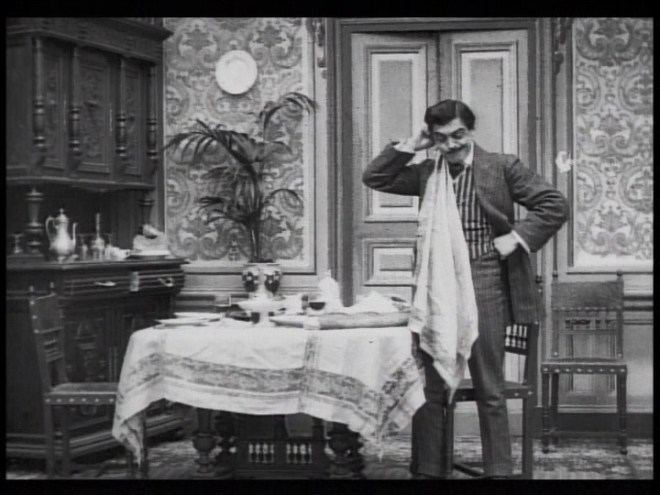
Linder was a beloved comedy figure in France and his films were regularly exported worldwide, which gives him a decent claim to be one of the first international superstars. Alas, while his name is well known in silent film circles, he doesn’t enjoy the same level of recognition as the silent comedians who followed. (Charlie Chaplin famously called Linder his professor.)
Troubles of a Grass Widower opens with Max sharing a meal with his wife but refusing to look up from his newspaper. His wife soon loses her temper and returns home to mother and Max is elated… at first. However, his attempts to wash the dishes with a garden hose, go shopping without anyone seeing him and cooking a chicken dinner all meet with disaster and he is soon begging his wife to return home. As was often the case in domestic comedies, accepted gender roles win the day but maybe Max will show his wife a bit more respect.

(At the time of this film’s release, a grass widow would have referred to a woman separated from her husband. I haven’t seen the phrase grass widower used in a non-humorous context.)
Silent domestic comedies are sometimes unfavorably compared to sitcoms but I would like to point out that we are four decades away from a television sitcom and these comedies were blazing the trail. Classic television sitcoms like I Love Lucy featured these Battle of the Sexes/Gender Roles Reversed episodes and the trope even made it to the big screen once again in films like Mr. Mom.

Suffice to say, there wouldn’t have been any I Love Lucy without pioneers like Linder so it’s not really fair to dismiss domestic comedy just because the gags were overused over the decades. We don’t say that we dislike Caligari because it reminds us of Tim Burton. (By the same token, I always roll my eyes a bit when people claim Linder isn’t as funny as Chaplin, Keaton or Lloyd. Guess who weren’t making films in 1908? Chaplin, Keaton and Lloyd. Respect the pioneers, dudes.)
Throughout the film, Linder’s Max continues to optimistically tackle one chore after another, certain that there just isn’t that much to the whole housewife business and that he will succeed brilliantly. What is there to making a stewed chicken besides a bird, some wine and a few veggies, right? Sure, the bird isn’t entirely plucked and there’s a bit of shoe polish in the pot (don’t ask) but it would come out fine in the end, won’t it? (It won’t, it doesn’t.)
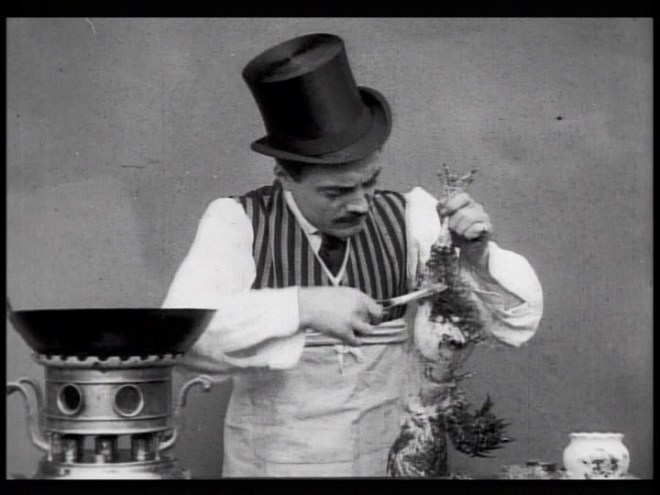
Troubles of a Grass Widower showcases Linder’s persona at its best: he’s a snotty fellow who gets himself into a terrible situation and then either is rescued or receives his comeuppance. In short, the kind of comedy he displayed in Max Learns to Skate.
The release date of Troubles of a Grass Widower has been confused with some sources listing 1908 and some listing 1912. As this film perfectly fits a description from a 1908 issue of The Moving Picture World, I am pretty confident that 1908 is indeed the correct date. From what I can tell, the problem seems to stem from a 1912 Linder comedy with a very similar plot entitled Max reprend sa liberté or Max Takes Back His Freedom, which is also called Troubles of a Grasswidower on IMDB. However, there are some significant changes to the plot that, in my opinion, weaken the comedy.
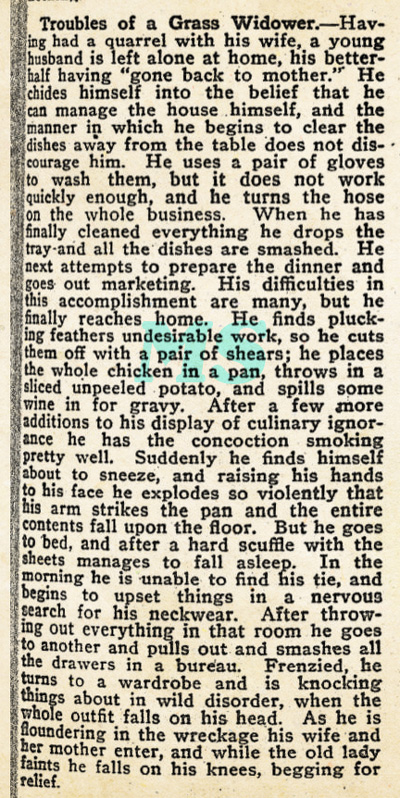
Much of the charm of Troubles of a Grass Widower is derived from Max almost getting things right. He kind of has an idea of how to make a chicken dish, how to make a bed, how to function without his wife but he gets things just wrong enough for disaster and hilarity to ensue. His growing frustration and anger as he realizes that house work is real work is the key to the film’s appeal.
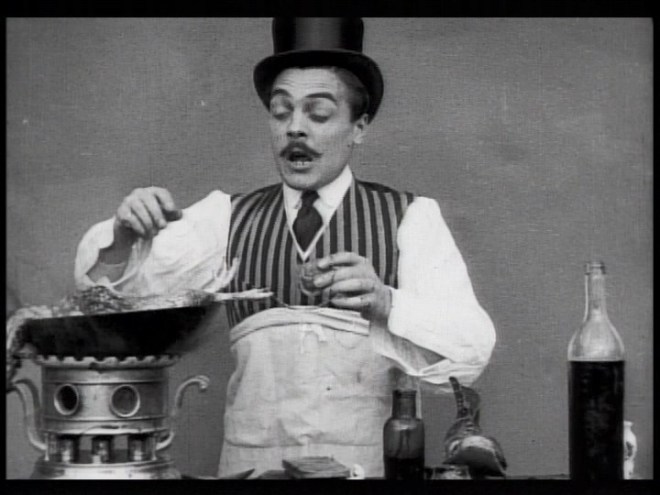
In Max Takes Back His Freedom, much of the runtime is spent with Max chasing his would-be chicken dinner with a pistol. The chicken proves to have more lives than a slasher movie villain and it’s all very slapsticky. Not entirely bad slapstick, mind you, but lacking that sparkle that we expect from our Max.
Further, the husband in Max Takes Back His Freedom is a pretty awful person. Rather than simply having a silly quarrel with his wife, the film opens with Max abusing the maid who serves their meal and then tearing a hairpiece from his wife’s head and dunking it in the soup tureen. I should point out that Linder’s pre-WWI comedy could and did go to some very dark places. For example, his 1906 comedy Attempted Suicide is a bitter satire of French bureaucracy and Max spends much of the runtime hanging by his neck from a noose. Grim viewing, especially for modern viewers who know that Linder killed himself less than two decades later.
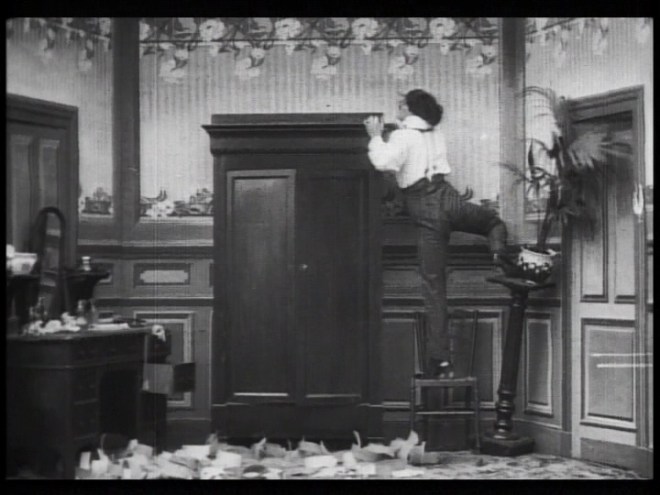
Max Takes Back His Freedom is not quite as disturbing but it does have a spitefulness to it and doesn’t really showcase the Max persona attractively. While Troubles of a Grass Widower has an arc for Max and a lesson learned (appreciate your wife!) Max Takes Back His Freedom is just Max being awful, continuing to be awful and no particular forward momentum is included. It seems more primitive, more Sennettesque. In fact, if you had reversed the dates and told me that Max Takes Back His Freedom was made before Troubles of a Grass Widower, I would have believed you.
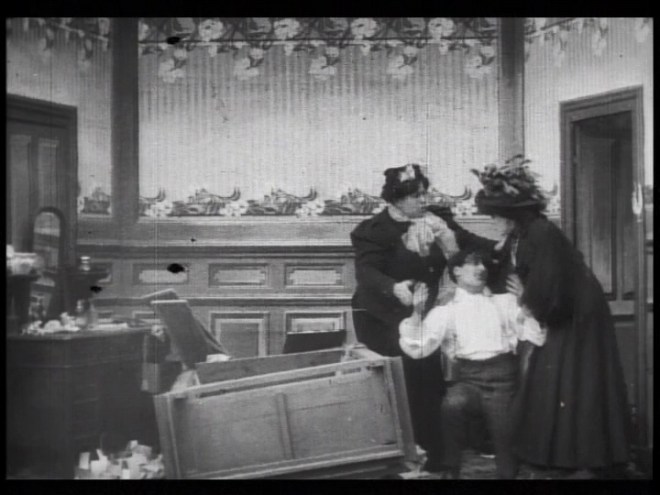
Troubles of a Grass Widower is an early example of a successful marital comedy poking fun at attempts to escape gender norms of the period. In the end, poor Max is forced to admit that he does indeed need his wife and begs her to return. I’m not sure if she got the good end of the deal considering the mess he has made but that’s for her to decide. At least life will never be boring.
This film is a great showcase for Linder and evidence of his charm and the reason why he appealed to audiences and became one of the first comedy superstars and one of the first film stars of any description. There aren’t many cuter ways to spend ten minutes.
Where can I see it?
Troubles of a Grass Widower has been released on DVD as part of the Laugh with Max Linder set and in the Movies Begin box set.
***
Like what you’re reading? Please consider sponsoring me on Patreon. All patrons will get early previews of upcoming features, exclusive polls and other goodies.

I just finished watching a dvd recording i made (maybe 10 yrs ago) from a TCM broadcast in which Robert Osborne introduced “from 1912, ,the TCM premiere of Max Linder in Troubles of a Grasswidower.” The brief title credits have the Path rooster and the title, “TROUBLES OF A GRASSWIDOWER,” in nice blocky font but not a copyright year. However. it is the exact film that you reviewed here. After about thirty seconds, I knew i was most likely watching a film from 1908, not 1912. It runs almost exactly ten minutes. It also matches the MPW review to a “T”. As you said, it must be a mixup with a different Linder film from 1912.
Yes, I agree completely, the trade review just sealed it for me. Could it be that the use of medium shots made experts think it was a later production? To me, that’s the only element that makes it look more modern than 1908 and there is a belief that (sigh) the use of closer shots for narrative purposes was invented by you-know-who. But, yeah, it’s 1908 all over, especially if you factor in the fashions worn by the ladies.
Just did a little research. It appears that Max Linder was using the medium shot for narrative purposes quite early. From “Film Style and Technology: History and Analysis” by Barry Salt (2nd Ed, 1992), Chapter 9: 1907-1913, in a discussion of the use “cut-ins” from a long shot to a medium shot during a scene, the author explains:
” . . . in 1909 Griffith did indeed make a couple of films that cut into and out of a Medium Shot in the middle of a scene, but in this case their function was to show an important detail, just as in an Insert Shot that only includes the object, and not the person using it. . . . On the other hand, in the Pathé films that Max Linder made from 1908 onwards, such as ‘The Would-be Juggler’ (1908) and ‘A Young Lady-Killer’ (1909), the function of the Medium Shot cut into the middle of the scene seems to be to get the maximum out of his facial expression.” (Salt,, pg. 92.)
In “Troubles of a Grasswidower” there are two scenes — the dish washing and the “chicken cooking” scenes — that cut from a long or “full” shot to a medium (from the waist) shot. Both serve the purpose of showing details — Max’s expressions of exasperation and bits of comedy business such as clipping the chicken’s feathers with scissors — that might otherwise be missed. And these are not merely quick “ïnsert” cuts to show an object such as a gun or a letter, but are shots that last for virtually the remainder of the scene.
The early use of this technique could indeed fool the viewer into thinking this was a film from, say, 1912 or 1913. Interestingly, the next film shown on TCM that evening was Linder’s “Max Takes a Picture” from 1913 (according to TCM), a film of mostly medium-long shots (from the knees up), that doesn’t have the more intimate bits of comedy “business” that would require a closer camera.
Yes, I hadn’t seen Grass Widower in a goodish stretch before reviewing it and remembered the medium shots and was thus prepared to give ear to the 1912 theory. Thanks for the quotes and I would also add that Linder uses a medium shot (heading into closeup) in Max Learns to Skate (1907 but some people say 1905, in which case, wow) when his character weeps in frustration. Again, this is used to enhance the narrative and feels organic, the way closeups would be employed later in the silent era.
I think we have a pretty decent case for Linder to be considered the father of the “grammar of film” at least as far as these closeups and medium shots are concerned.
And can we talk about the sophisticated cutting in Attempted Suicide, which is from 1906? Plus, we get an early example of a pan as the camera follows the boy in the woods who stumbles on Max’s body. Again, a technique being employed to enhance the narrative. (Boy moves, so does camera, boy and audience make the macabre discovery together.)
https://archive.org/details/AttemptedSuicideLePendu1906
P.S. I should add the director of those two earlier shorts is Louis J. Gasnier, which thickens the plot considerably.
One thing that strikes me about the origin(s) of new film techniques was that they weren’t exactly the product of a “Eureka!” moment where every other filmmaker or wannabe who saw a new method suddenly decided to use it in their next film. Even among the directors who were early adopters (if not inventors), “new” methods seem to have been adopted gradually.
For example in the hundreds of Biographs that survive from 1908 to 1913, Griffith may have used these cut-ins from a full to medium shot within a scene only a handful of times, maybe three or four out of 300 films, And Max Linder (and Messr. Gasnier) may have used it earlier and more frequently, but the rest of European and US filmmakers not so much? Was comedy a more fertile ground for experimentation? So many questions 😉
It may have been around 1912-13 before it became a common element of film “grammar.” And one more question: Can we have definitive answers to our many questions when only a fraction of the total film output of the period survives for us to study?
Oh yes, definitely. In real life, “Eureka!” is far less common than we like to believe and it’s all really a lot of sweat and elbow grease. Alas, that doesn’t make for a good interview so eureka it is. In fact, I would go so far as to say that if 100% of all cinematic output was suddenly available, we would be shocked by what was done, how early and by whom.